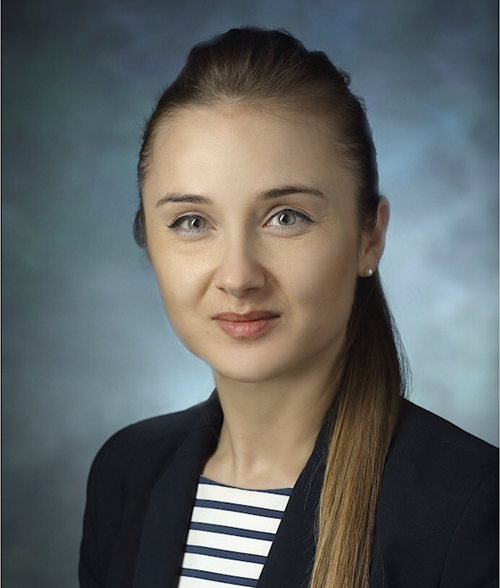
The AP's Role In Managing Patients With Early-Stage Multiple Myeloma
Case 2: Standard-Risk Patients
Patricia A. Mangan, RN, MSN, CRNP, Amy Pierre, MSN, RN, ANP-BC, and Oxana Megherea, PharmD, BCOP, review a case study of a patient with multiple myeloma who is not eligible for a transplant. They also discuss equity in care and how treatment outcomes can be negatively affected in underrepresented racial and ethnic groups.
Chair

Patricia A. Mangan
RN, MSN, CRNP
University of Pennsylvania Abramson Cancer Center
Faculty

Amy Pierre
MSN, RN, ANP-BC
Memorial Sloan Kettering Cancer Center and Flatiron Health

Oxana Megherea
PharmD, BCOP
Penn Medicine
Transcript
Patricia Mangan: Another topic or case that might highlight a patient in a standard-risk issue is an elderly woman who is 82 and she presented to her community emergency room for an evaluation after 2 months of low back pain that has been getting progressively worse. She now presents there with significant pain actually impairing her mobility. She did have x-rays conducted and did show lytic lesions in her lumbar spine. Then she was, due to her pain management issues, admitted for further workup. She did undergo an MRI of her L spine, which did show a large lytic lesion with compression deformities in her L1 and L2, and even a soft tissue mass at L2. Fortunately, there was no evidence of spinal cord compression.
Her laboratory work did a reveal an igA kappa, SPEP with a 2.3 gram and an IgG quantitative level of 960, an IGA level of 2070, and an IgM of 15, kappa-lambda ratio was elevated, and absolute kappa was 235, and lambda was 5. She underwent a bone marrow biopsy, and she had 35% plasma cells. Cytogenetic evaluation did reveal a translocation 11;14. I'd love to hear your thoughts on your approach to this population and, Amy, thinking of your interest in access to care and health in equity issues, I'd love to hear your thoughts, particularly in highlighting this case.
Amy Pierre: This is interesting because I think this scenario happens a lot. There are patients who are experiencing bone discomfort, boney issues, back pain predominantly, and sort of circling different providers. Studies show that patients see about three providers before they're actually diagnosed with multiple myeloma (MM). So, you're looking at a delay in diagnostics there. When we look at access to medications, we know that there are certain underrepresented racial and ethnic groups, particularly Black patients, with MM who are less likely to receive immunomodulatory drugs, proteasome inhibitors, all those novel standard-of-care therapeutics we're using upfront. For some reason, those patients are not getting those drugs. We also see that Black patients are diagnosed about 4 or 5 years younger than the average age of a patient who's white. So, we think as a whole, the average age of diagnosis is age 69, but for Black patients and Latinx patients, it's more like 65, 66, and for white patients, it's actually 71.
We have a little bit of a younger population who are not getting the right access to drugs. We also see delays in stem cell transplant therapy, delays in referral to stem cell transplant. We also see a minimal amount of patients of color participating in clinical trials, myeloma trials, which is unusual because Black patients are two to three times more likely to develop MM than a white patient. When we look at who's comprising those clinical trials, we're seeing less than 5% of Black patients in myeloma clinical trials and they're probably making up anywhere between 20% to 24% of the myeloma population. So, Black patients are definitely at a disadvantage in the myeloma space. They're twice as likely to die from their disease compared to white patients even though they have a lower risk cytogenetics component to their disease.
We do know that when you treat Black patients in an equal access system with standard of care, they do have the opportunity to do as well as others, if not even better, due to their low-risk cytogenetic features that they have. As providers, we need to be aware of these inequities, be cognizant of it, and understand that sometimes unconscious bias may play a role in how we're caring for patients in terms of access and resources. I encourage everyone to take an implicit bias test. You'll learn a lot about yourself. They're free online, I believe Harvard has developed one that you can access. And make sure we are willing to learn from patients, make sure we're participating in cultural humility. Understand the role of outside factors in medical decision-making for patients, whether it be family or extended family, and really learn from your patient and what their preferences are. And make sure you're treating them as an individual and giving them the resources that they need to have standard of care, equitable care so they can maximize their progression-free survival on overall survival outcomes.
Patricia Mangan: That's very helpful. Being aware of these things was just so important as we care for our patients. I do think in this particular case another thing that I think of, Oxana, was figuring out that this patient is elderly and is probably not a great transplant candidate. I’m just wondering in terms of the approach to this patient, what initial therapies would you think of for someone like that? Is there anything in particular that you would lean towards and think of for this particular patient?
Oxana Megherea: Of course. I think daratumumab is certainly something that we started utilizing a lot more in this setting. We have two different trials that have shown an overall survival benefit with the addition of daratumumab to a doublet and a triplet. Really what I think we use the most in the United States, it's daratumumab with lenalidomide and dexamethasone based on the results of the MAIA trial. The MAIA trial looked at transplant-ineligible patients and they randomized patients to receiving daratumumab with lenalidomide and dexamethasone versus lenalidomide dexamethasone at the typical dosing that we see utilized in this setting until progression or intolerance. And at, I believe it's 56-plus months, neither the progression-free survival or the overall survival have been met yet with significant improvements in both, which is incredible in this setting.
With the addition of daratumumab to a doublet or a triplet, we have a slightly higher risk of a cytopenias, and we also have a slightly higher risk of infections, specifically pneumonia. We now have strategies that we can employ to mitigate that risk of cytopenias with the use of granulocyte colony-stimulating factors, or infections with adequate immunization in this patient population, especially against pneumococcal disease. Now there is emerging data on steroid-sparing strategies. For example, doing daratumumab with lenalidomide instead of the triplet; it seems promising efficacy at this point of 12 months of follow-up and a reduction in both cytopenias and infections, which would be especially important in this patient population.
We still have VRd, which has been studied based on the SWOG study. It has been studied in this setting and it showed an overall survival benefit. However, when we look at the update at 84 months of follow-up, when looking at the older population, so patients over 65 years of age, that overall survival was not as statistically significant. It's something to keep in mind. I don't believe we'll have head-to-head comparisons between the two regimens that I know of at this point. But it remains a regimen. We do have the additive toxicity risk, or toxicity considerations, with VRd, especially in a patient that is older, may have comorbid conditions, where we do see a little more neurological toxicity and a little more GI toxicity with VRd. Those are some of the considerations we have when selecting between the options that we have for this patient population.
Patricia Mangan: I agree. Having that length of therapy and managing toxicity and comfort, this is a marathon, not a sprint. Having the patients dose-reduce as you mentioned, maybe lowering that steroid dose that’s causing such toxicity or even eliminating it, many of our patients love that. Waiting for the clinical data to come out, it takes time. Another point that was raised earlier is a valid one where in this population a woman like 82, maybe with standard-risk disease, starting with the doublet but then monitoring and making sure that she's meeting her milestones of response and maintaining it, but if not happening quick enough, adding in a third agent, people start to feel better and they can tolerate that. But very mindful, again, of the toxicities of infection. As we add agents, you know, doublet versus a triplet, we know that with triplets there is an uptick in infection and other side effects. Being mindful of that I think is very helpful.
I appreciate your information and great help to figure out these higher-aged, or more frail patients I should say, and how to deal with them, and particularly access issues, which I think we always have to be mindful of.
